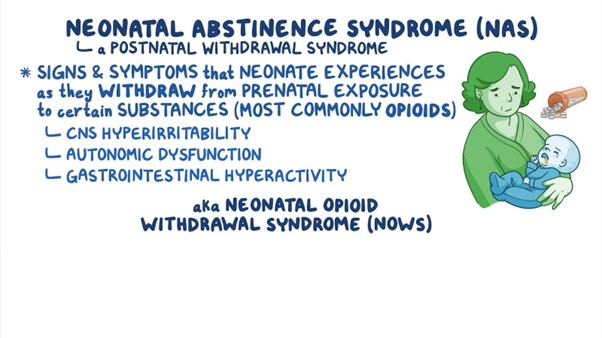A nurse is assessing a neonate who was exposed to heroin in utero. Which of me following findings should the nurse identify as an indication that the neonate is experiencing neonatal abstinence syndrome?
Hyporeflexia
Frequent yawning
Respiratory depression
Constipation
The Correct Answer is A
Neonatal abstinence syndrome (NAS) is a group of withdrawal symptoms that occur in newborns who were exposed to drugs, including heroin, in utero. Hyporeflexia, which refers to reduced or diminished reflexes, is one of the key findings in neonates experiencing NAS.
During pregnancy, when the mother uses opioids like heroin, the baby becomes dependent on the drug. After birth, when the drug is no longer available, the baby experiences withdrawal symptoms as the body adjusts to the absence of the drug. Hyporeflexia is a common manifestation of NAS and is observed due to the central nervous system's response to the withdrawal.
Let's go through the other options:
B. Frequent yawning: While yawning can be seen in neonates with NAS, it is not as specific to the condition as hyporeflexia. Yawning can occur for various reasons and may not always be indicative of NAS.
C. Respiratory depression: Respiratory depression can be a severe complication of opioid exposure in utero and can result in life-threatening situations for the neonate. However, it is not specific to NAS. Respiratory depression is more closely associated with opioid overdose in the newborn, which can be a separate concern from NAS.
D. Constipation: Constipation is a possible symptom in neonates experiencing NAS, but it is not as specific as hyporeflexia. Constipation can occur due to various factors and is not unique to NAS.

Nursing Test Bank
Naxlex Comprehensive Predictor Exams
Related Questions
Correct Answer is C
Explanation
The nurse should monitor the client receiving long-term treatment with oral doses of prednisone for the development of osteoporosis. Prednisone is a corticosteroid medication that can lead to decreased bone density and increase the risk of fractures. Prolonged use of prednisone can interfere with calcium absorption and increase bone resorption, leading to osteoporosis.
Hypoglycemia (A) is not a common adverse effect of prednisone. In fact, prednisone can cause hyperglycemia and increase the risk of developing diabetes.
Hyperreflexia (B) is not typically associated with prednisone use. Hyperreflexia is an exaggerated reflex response and is not a common adverse effect of corticosteroid therapy.
Inflammatory bowel disease (D) is not an adverse effect of prednisone. In fact, prednisone is often used as a treatment for inflammatory bowel disease to reduce inflammation and symptoms.
Therefore, the nurse should primarily monitor the client for the development of osteoporosis when receiving long-term treatment with oral doses of prednisone.
Correct Answer is B
Explanation
Before administering the first dose of metformin, the nurse should evaluate the client's creatinine level. Metformin is primarily excreted by the kidneys, and its clearance from the body depends on the renal function. If the client has impaired kidney function, metformin can accumulate in the body and lead to potential adverse effects, particularly lactic acidosis.
Monitoring the creatinine level helps assess the client's kidney function and determines whether it is safe to administer metformin. If the creatinine level is elevated, indicating reduced kidney function, the nurse should consult with the healthcare provider to determine the appropriate dose adjustment or consider an alternative treatment option.
Let's go through the other options and explain why they are not the priority laboratory results to evaluate before administering metformin:
A. Potassium level: While monitoring potassium levels is important in some situations, it is not a primary concern before administering metformin. Metformin does not have a significant effect on potassium levels, and it is not a medication known for causing hypokalemia (low potassium levels).
C. Platelet count: Metformin does not have a direct impact on platelet count, and evaluating platelet count is not typically required before starting metformin therapy. Platelet count monitoring may be relevant for certain other medications or medical conditions, but it is not specific to metformin administration.
D. Liver enzymes: While it is essential to monitor liver function in clients on long-term metformin therapy, evaluating liver enzymes before the first dose of metformin is not the priority. Metformin is primarily cleared by the kidneys, and liver enzymes are not directly affected by its initial administration. However, ongoing monitoring of liver function may be necessary during long-term
Whether you are a student looking to ace your exams or a practicing nurse seeking to enhance your expertise , our nursing education contents will empower you with the confidence and competence to make a difference in the lives of patients and become a respected leader in the healthcare field.
Visit Naxlex, invest in your future and unlock endless possibilities with our unparalleled nursing education contents today
Report Wrong Answer on the Current Question
Do you disagree with the answer? If yes, what is your expected answer? Explain.
Kindly be descriptive with the issue you are facing.
